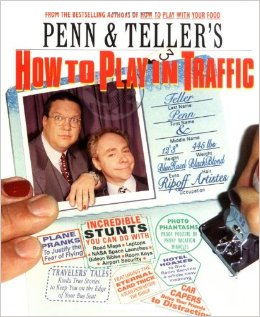MARIANO TOMATISWONDER INJECTORItalian writer and magician
|
 Magic & ZenRe-enchanting airports with the Five Cent Koan Posted on wednesday 6 august 2014, 2 days before scifoo14 • Written by Mariano TomatisAn airport can be a sanctuary for philosophers. There may be tinny loudpeakers and beeping carts, and masses of humanity screaming, kissing, arguing, and gobbling. But if you know where to look, an airport is as good a place as the Himalayas for contemplating the big picture. (1)  A sidewalk in San Francisco Airport. Tomorrow it will take me 22 hours to get to Palo Alto (CA) from Turin (Italy) and whenever I spend some time in an airport, I come back to “The Five Cent Koan” — a short essay written by two of my favourite thinkers. The opening paragraphs of this post come from it. The Koan is not like the tricks you use to baffle other people. You use it to fool yourself. (2) Believing that airports need some sort of re-enchantment more than any other place, I think “The Five Cent Koan” is the perfect solution — and tomorrow, as always, I will perform it. This is the reaction I will get, in the words of its creator: You may find yourself unexpectedly grinning like a Tibetan monk while your fellow travelers fret their trips away. (3)  They are not Eastern Gurus nor academic scholars. They label themselves as two “eccentric guys who have learned how to do a few cool things”, but they are a couple of truly subversive counter-culture tricksters: they are the magic duo Penn & Teller. “The Five Cent Koan” has been published on their book Penn & Teller’s How To Play in Traffic, a stunning collection of magic tricks totally out-of-the-box. The instructions are simple: Take out a nickel. [...] Now find a moving sidewalk. [...] Place your nickel on the black handrail that moves with the sidewalk. Stay where you are, and watch your coin glide away. As it retreats, think to yourself: My nickel is vanishing into oblivion. [...] Wait at least sixty seconds [...] Then get on the moving sidewalk yourself. Ride it to the end. When you get off, look around. Search the floor. The nickel will be gone. (4) That’s all. But the tiny experience fosters comments upon the possible reactions by Aristotle, Sir Arthur Conan Doyle, and even Marie Curie — dealing with the eternal debate between Faith and Reason. Then you are invited to think about that horrible kid that in the schoolyard, decades ago, punched you in the shoulder until you were ready to kill him. At the time it seemed like the end of your life. But now, where has he gone? He rode the black handrail into oblivion. Just like the coin, he went farther and farther away until he was no longer part of your world. (5) But then that coin becomes the occasion of meditating upon Getting and Losing. When you put your nickel on the handrail, you resigned yourself to the fact that it was gone, spent on a frivolous philosophical experiment. (6) But if you find it again at the end of the sidewalk, then you are allowed to feel richer than before! You may congratulate with yourself for being in the right place at the right time. So you have a no-lose situation: If the coin is gone, you win a mystery. If the coin is there, you win the envy of your fellow travelers. (7) If all books about magic tricks were like this... _________________ (1) Penn & Teller, Penn & Teller’s How To Play in Traffic, The Berkley Publishing Group, New York 1997, p. 187. (2) Ibidem. (3) Ibidem. (4) Ibidem. (5) Penn & Teller, p. 190. (6) Penn & Teller, p. 192. (7) Ibidem. You could be interested also in:
|
 Science Foo Camp (or “Sci Foo”) is an invitation-only gathering organized by Digital Science, O'Reilly Media, and Google, with support from Nature. The 9th edition of Sci Foo takes place on 8-10 August 2014 at the Googleplex in Mountain View, CA. Lord Martin Rees has defined it as “a sort of mini Woodstock of the Mind”. Participants include researchers, writers, educators, artists, policy makers, investors, and other thought leaders, all doing groundbreaking work in diverse areas of science and technology.
Science Foo Camp (or “Sci Foo”) is an invitation-only gathering organized by Digital Science, O'Reilly Media, and Google, with support from Nature. The 9th edition of Sci Foo takes place on 8-10 August 2014 at the Googleplex in Mountain View, CA. Lord Martin Rees has defined it as “a sort of mini Woodstock of the Mind”. Participants include researchers, writers, educators, artists, policy makers, investors, and other thought leaders, all doing groundbreaking work in diverse areas of science and technology.